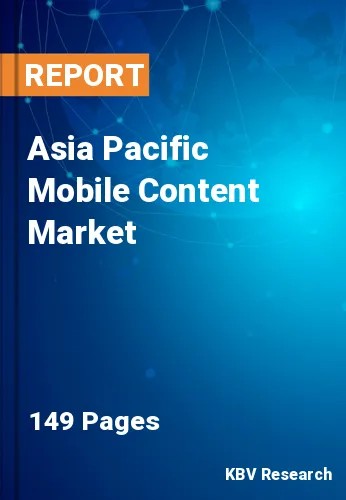Chapter 1. Market Scope & Methodology
1.1 Market Definition
1.2 Objectives
1.3 Market Scope
1.4 Segmentation
1.4.1 Asia Pacific Mobile Content Market, by Content Type
1.4.2 Asia Pacific Mobile Content Market, by Platform
1.4.3 Asia Pacific Mobile Content Market, by Revenue Model
1.4.4 Asia Pacific Mobile Content Market, by Country
1.5 Methodology for the research
Chapter 2. Market at a Glance
2.1 Key Highlights
Chapter 3. Market Overview
3.1 Introduction
3.1.1 Overview
3.1.1.1 Market Composition and Scenario
3.2 Key Factors Impacting the Market
3.2.1 Market Drivers
3.2.2 Market Restraints
3.2.3 Market Opportunities
3.2.4 Market Challenges
Chapter 4. Competition Analysis - Global
4.1 KBV Cardinal Matrix
4.2 Recent Industry Wide Strategic Developments
4.2.1 Partnerships, Collaborations and Agreements
4.2.2 Product Launches and Product Expansions
4.2.3 Acquisition and Mergers
4.3 Market Share Analysis, 2023
4.4 Top Winning Strategies
4.4.1 Key Leading Strategies: Percentage Distribution (2020-2024)
4.4.2 Key Strategic Move: (Partnerships, Collaborations and Agreements: 2023, Apr – 2024, Sep) Leading Players
4.5 Porter Five Forces Analysis
Chapter 5. Asia Pacific Mobile Content Market by Content Type
5.1 Asia Pacific Games Market by Country
5.2 Asia Pacific Mobile Apps Market by Country
5.3 Asia Pacific Music Market by Country
5.4 Asia Pacific Other Content Type Market by Country
Chapter 6. Asia Pacific Mobile Content Market by Platform
6.1 Asia Pacific Android Market by Country
6.2 Asia Pacific iOS Market by Country
6.3 Asia Pacific Other Platform Market by Country
Chapter 7. Asia Pacific Mobile Content Market by Revenue Model
7.1 Asia Pacific In-App Purchases Market by Country
7.2 Asia Pacific Advertising Market by Country
7.3 Asia Pacific Subscription Market by Country
7.4 Asia Pacific Pay-per-Downloads Market by Country
7.5 Asia Pacific Other Revenue Model Market by Country
Chapter 8. Asia Pacific Mobile Content Market by Country
8.1 China Mobile Content Market
8.1.1 China Mobile Content Market by Content Type
8.1.2 China Mobile Content Market by Platform
8.1.3 China Mobile Content Market by Revenue Model
8.2 Japan Mobile Content Market
8.2.1 Japan Mobile Content Market by Content Type
8.2.2 Japan Mobile Content Market by Platform
8.2.3 Japan Mobile Content Market by Revenue Model
8.3 India Mobile Content Market
8.3.1 India Mobile Content Market by Content Type
8.3.2 India Mobile Content Market by Platform
8.3.3 India Mobile Content Market by Revenue Model
8.4 South Korea Mobile Content Market
8.4.1 South Korea Mobile Content Market by Content Type
8.4.2 South Korea Mobile Content Market by Platform
8.4.3 South Korea Mobile Content Market by Revenue Model
8.5 Singapore Mobile Content Market
8.5.1 Singapore Mobile Content Market by Content Type
8.5.2 Singapore Mobile Content Market by Platform
8.5.3 Singapore Mobile Content Market by Revenue Model
8.6 Malaysia Mobile Content Market
8.6.1 Malaysia Mobile Content Market by Content Type
8.6.2 Malaysia Mobile Content Market by Platform
8.6.3 Malaysia Mobile Content Market by Revenue Model
8.7 Rest of Asia Pacific Mobile Content Market
8.7.1 Rest of Asia Pacific Mobile Content Market by Content Type
8.7.2 Rest of Asia Pacific Mobile Content Market by Platform
8.7.3 Rest of Asia Pacific Mobile Content Market by Revenue Model
Chapter 9. Company Profiles
9.1 Google LLC (Alphabet Inc.)
9.1.1 Company Overview
9.1.2 Financial Analysis
9.1.3 Segmental and Regional Analysis
9.1.4 Research & Development Expense
9.1.5 Recent strategies and developments:
9.1.5.1 Partnerships, Collaborations, and Agreements:
9.1.5.2 Product Launches and Product Expansions:
9.1.6 SWOT Analysis
9.2 Microsoft Corporation
9.2.1 Company Overview
9.2.2 Financial Analysis
9.2.3 Segmental and Regional Analysis
9.2.4 Research & Development Expenses
9.2.5 Recent strategies and developments:
9.2.5.1 Product Launches and Product Expansions:
9.2.5.2 Acquisition and Mergers:
9.2.6 SWOT Analysis
9.3 Meta Platforms, Inc.
9.3.1 Company Overview
9.3.2 Financial Analysis
9.3.3 Segment and Regional Analysis
9.3.4 Research & Development Expense
9.3.5 Recent strategies and developments:
9.3.5.1 Partnerships, Collaborations, and Agreements:
9.3.5.2 Product Launches and Product Expansions:
9.3.6 SWOT Analysis
9.4 Sony Corporation
9.4.1 Company Overview
9.4.2 Financial Analysis
9.4.3 Segmental and Regional Analysis
9.4.4 Research & Development Expenses
9.4.5 Recent strategies and developments:
9.4.5.1 Partnerships, Collaborations, and Agreements:
9.4.6 SWOT Analysis
9.5 Apple, Inc.
9.5.1 Company Overview
9.5.2 Financial Analysis
9.5.3 Regional Analysis
9.5.4 Research & Development Expense
9.5.5 Recent strategies and developments:
9.5.5.1 Partnerships, Collaborations, and Agreements:
9.5.6 SWOT Analysis
9.6 Huawei Technologies Co., Ltd. (Huawei Investment & Holding Co., Ltd.)
9.6.1 Company Overview
9.6.2 Financial Analysis
9.6.3 Segmental and Regional Analysis
9.6.4 Research & Development Expenses
9.6.5 Recent strategies and developments:
9.6.5.1 Partnerships, Collaborations, and Agreements:
9.6.6 SWOT Analysis
9.7 Nintendo Co., Ltd.
9.7.1 Company Overview
9.7.2 Financial Analysis
9.7.3 Regional Analysis
9.7.4 Research & Development Expenses
9.7.5 Recent strategies and developments:
9.7.5.1 Partnerships, Collaborations, and Agreements:
9.7.5.2 Acquisition and Mergers:
9.7.6 SWOT Analysis
9.8 Amazon.com, Inc.
9.8.1 Company Overview
9.8.2 Financial Analysis
9.8.3 Segmental Analysis
9.8.4 Recent strategies and developments:
9.8.4.1 Product Launches and Product Expansions:
9.8.4.2 Acquisition and Mergers:
9.8.5 SWOT Analysis
9.9 ByteDance Ltd.
9.9.1 Company Overview
9.9.2 Recent strategies and developments:
9.9.2.1 Partnerships, Collaborations, and Agreements:
9.9.2.2 Acquisition and Mergers:
9.9.3 SWOT Analysis
9.10. Samsung Electronics Co., Ltd. (Samsung Group)
9.10.1 Company Overview
9.10.2 Financial Analysis
9.10.3 Segmental and Regional Analysis
9.10.4 Research & Development Expenses
9.10.5 SWOT Analysis

